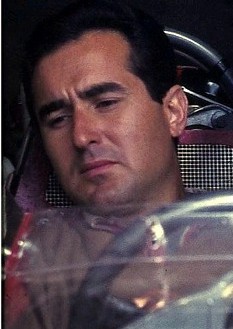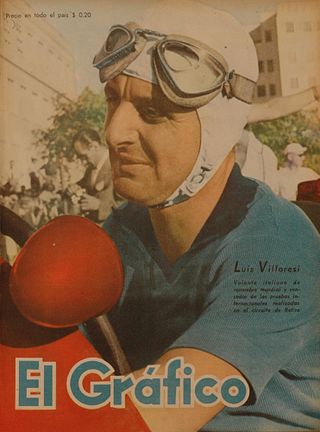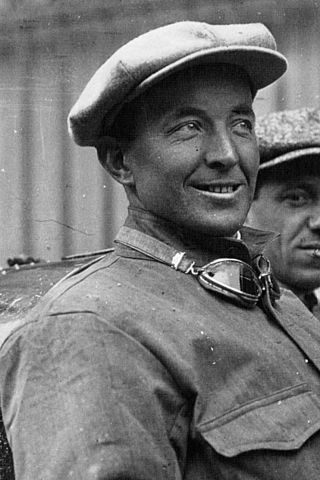
Enzo Anselmo Giuseppe Maria Ferrari was an Italian motor racing driver and entrepreneur, the founder of the Scuderia Ferrari Grand Prix motor racing team, and subsequently of the Ferrari automobile marque. He was widely known as Il Commendatore or Il Drake. In his final years he was often referred to as L'Ingegnere or Il Grande Vecchio.

Lorenzo Bandini was an Italian motor racing driver who raced in Formula One for the Scuderia Centro Sud and Ferrari teams.

Luigi Villoresi was an Italian Grand Prix motor racing driver who started racing in Formula One at the time of its inception.

Giancarlo Baghetti was a Formula One driver who raced for the Ferrari, Automobili Turismo e Sport, BRM, Brabham and Lotus teams.

Pietro Bordino was an Italian racecar driver.

Amedeo "Amédée" Gordini was an Italian-born race car driver and sports car manufacturer in France.

The 1906 Grand Prix de l'Automobile Club de France, commonly known as the 1906 French Grand Prix, was a motor race held on 26 and 27 June 1906, on closed public roads outside the city of Le Mans. The Grand Prix was organised by the Automobile Club de France (ACF) at the prompting of the French automobile industry as an alternative to the Gordon Bennett races, which limited each competing country's number of entries regardless of the size of its industry. France had the largest automobile industry in Europe at the time, and in an attempt to better reflect this the Grand Prix had no limit to the number of entries by any particular country. The ACF chose a 103.18-kilometre (64.11 mi) circuit, composed primarily of dust roads sealed with tar, which would be lapped six times on both days by each competitor, a combined race distance of 1,238.16 kilometres (769.36 mi). Lasting for more than 12 hours overall, the race was won by Ferenc Szisz driving for the Renault team. FIAT driver Felice Nazzaro finished second, and Albert Clément was third in a Clément-Bayard.
The 1906 Grand Prix season is regarded as the first Grand Prix racing season. It marked the advent of two iconic races: The French Grand Prix and the Targa Florio.

The 1927 Grand Prix season was the third AIACR World Manufacturers' Championship season and the second run to a 1.5-litre engine limit. In a dominant display, the championship was won by Delage, with team driver Robert Benoist winning four of the five Grand Prix.
The 1907 Grand Prix season was the second Grand Prix racing season. It saw a blossoming of circuit events, with the shift from the inter-city races. The popularity of the inaugural French Grand Prix and Targa Florio saw those events held again. The new Kaiserpreis was the first major motor-race held in Germany. This year also saw a number of voiturette races as the number of specialist small-engine cars grew which gave close, exciting racing very popular with spectators.

The 1908 Grand Prix season was the third Grand Prix racing season. An international economic recession affected motor-racing with fewer races and smaller fields. However, in consequence, it also saw an increase in the number of smaller cars and voiturette racing. This gave close racing between the teams from Lion-Peugeot, Sizaire-Naudin and Delage. Both the major races in Europe, the Targa Florio and French Grand Prix, had precursor voiturette races, and along with the Coupe des Voiturettes, the honours were shared between those three manufacturers. This year’s Targa Florio had a small, but quality, field. Vincenzo Trucco won for Isotta-Fraschini with better mechanical reliability, after a close duel with the FIATs of Felice Nazzaro and Vincenzo Lancia.
The 1911 Grand Prix season consisted of Grand Prix races in the United States and Europe. It was a significant year as European racing gradually came out of the doldrums. A Grand Prix was held in France again. The first Indianapolis 500 was held at Indianapolis Motor Speedway, joining the American Grand Prize as a leading race.
The 1912 Grand Prix season saw Grand Prix motor racing in Europe and the United States. The growing economic confidence and interest from car manufacturers saw bigger fields and more races in the season. The French Grand Prix was held for the first time since 1908 and staged at Dieppe. The American Grand Prize was held in Milwaukee, moving from its previous home in Savannah.

The 1921 Grand Prix season saw motor racing in Europe blossom again. The French Grand Prix was held for the first time since 1914, at La Sarthe, Le Mans. and the inaugural Italian Grand Prix was held in Montichiari, near Brescia. The 3-litre formula of the AIACR, already in use at Indianapolis, was adopted by those Grand Prix meaning manufacturers could design on a common formula.

The 1922 Grand Prix season had several notable events during the year. The AIACR governing body brought in a 2-litre formula for Grand Prix. French companies brought out straight-8 engines for their cars but it was FIAT's 6-cylinder engine that took the trophies. Veteran Felice Nazzaro won the French Grand Prix, held near Strasbourg. It was a tainted victory though, as Nazzaro's nephew was killed when his FIAT's suspension broke in the latter stages of the race. An almost identical accident also happened to team-mate Pietro Bordino, though he was only slightly injured. Pierre de Vizcaya's Bugatti finished second, nearly an hour behind.

The 1923 Grand Prix season was part of a watershed year for motor racing that saw significant advances in motor-racing engineering, design and events. Fiat's chief designer, Guido Fornaca, developed the 805, the first supercharged car to win a Grand Prix. Benz appeared with the first mid-engined racer and, along with Bugatti and Voisin, produced some of the first efforts at aerodynamics on racing cars. With the United States also adopting the 2-litre formula, Harry Miller could use the smaller engine size to design the first single-seater race-car, ideally suited to American oval racing.

The 1924 Grand Prix season saw Grand Prix motor racing spread further across Europe and North America. In Italy a number of new open-road events were held. In France two new circuits were opened – at Montlhéry near Paris and Miramas near Marseille.

The 1923 French Grand Prix was a Grand Prix motor race held at Tours on 2 July 1923. The race was run over 35 laps of the 22.83 km circuit for a total distance of just under 800 km and was won by Henry Segrave driving a Sunbeam. This race is notable as the first Grand Épreuve to be won by either a British driver or a British car. The race also featured several innovative new technologies, including the first appearance of both supercharging and V12 engines in Grand Prix racing.

The 1909 Grand Prix season was the fourth Grand Prix racing season. There were no Grandes Épreuves that year, as the economic recession of the previous year continued on. Renault had withdrawn from motor-racing and a number of French manufacturers, falling behind the success of their German and Italian rivals, followed suit. The French Grand Prix was cancelled, leaving the Targa Florio in Italy and Vanderbilt Cup in the United States as the only major races this season. With so little competition and financial incentive, technological advances ground to a halt. Emphasis shifted from racing to setting speed and endurance records. Benz & Cie built a new 12.4-litre racing-engine, and its 200 bhp derivative was put into the Blitzen Benz. This 21.5-litre monster held the Land speed record from 1909 to 1922, with various drivers starting with Victor Hémery in November, 1909 at Brooklands.

The Fiat 130 HP is a Grand Prix racing car made by Fiat in 1907 to a design by Giovanni Enrico. Built solely for Grand Prix motor racing, the Fiat 130 HP included new design features, such as overhead valves and hemispherical compression chambers.
















